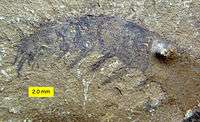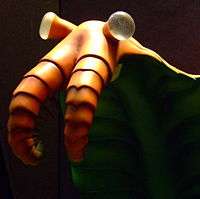Great appendage


Great appendages are large claw-like appendages which attach to the heads of the "great appendage arthropods", a group whose monophyly is debated, but which includes the anomalocaridids. The great appendages are used in food manipulation; Anomalocaris used them to manipulate prey such as trilobites,[1] while Laggania used them to filter algae and similar small particles from the water in which it dwelt. They have been suggested to be homologous with the antennule of the euarthropods,[2] or the chelicerae of chelicerates,[3] although the latter possibility has been discounted.[4][5]
Two types of great appendage are recognised; the first, the long great appendage such as that seen in the anomalocaridids, resembles a 15–unit leg; whereas the more ubiquitous short great appendage characteristic of the Megacheira is arm-like with a claw-like end. The latter form is a synapomorphy of the euarthopods and may be homologous with the large great appendage.[2]
References
- ↑ Nedin, Christopher (1999). "Anomalocaris predation on nonmineralized and mineralized trilobites". Geology. 27 (11): 987–990. Bibcode:1999Geo....27..987N. doi:10.1130/0091-7613(1999)027<0987:APONAM>2.3.CO;2.
- 1 2 Stein, Martin (2010). "A new arthropod from the Early Cambrian of North Greenland, with a 'great appendage'-like antennula". Zoological Journal of the Linnean Society. 158 (3): 477–500. doi:10.1111/j.1096-3642.2009.00562.x.
- ↑ Dornbos, Stephen; Bottjer, David; Chen, Jun-Yuan (2004). "Evidence for seafloor microbial mats and associated metazoan lifestyles in Lower Cambrian phosphorites of Southwest China" (PDF). Lethaia. 37 (2): 127–137. doi:10.1080/00241160410004764.
- ↑ Jager, Muriel; Murienne, Jérôme; Clabaut, Céline; Deutsch, Jean; Le Guyader, Hervé; Manuel, Michaël (2006). "Homology of arthropod anterior appendages revealed by Hox gene expression in a sea spider". Nature. 441: 506–508. doi:10.1038/nature04591. PMID 16724066.
- ↑ Myers, PZ (May 26, 2006). "Chelifores, chelicerae, and invertebrate evolution". Pharyngula.